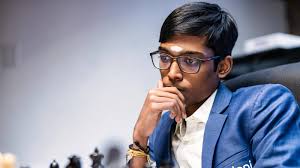Praggnanandhaa interview: ‘I don’t think we are better than Carlsen, Nakamura and Caruana, but as a generation, we are fighting on equal terms now’

Indian Grandmaster R. Praggnanandhaa reflects on the changing landscape of world chess, as a new generation challenges long-time titans like Carlsen, Nakamura, and Caruana.
In a strikingly honest and humble reflection, Indian chess prodigy Rameshbabu Praggnanandhaa recently commented on the evolving dynamics in elite chess. “I don’t think we are better than Carlsen, Nakamura and Caruana,” he said. “But as a generation, we are fighting on equal terms now.” His words capture the essence of a global shift: the emergence of a fearless and competitive new generation that’s beginning to make its mark on the game once dominated by a few towering figures.
At just 18 years old, Praggnanandhaa has already faced—and beaten—some of the greatest names in modern chess. His victories over Magnus Carlsen, especially in rapid formats, have drawn international attention. Yet, he maintains a deep respect for those who paved the way.
The Titans Still Stand Tall
The trio of Carlsen, Nakamura, and Caruana has defined elite chess for over a decade. Carlsen, the former World Champion and arguably the greatest player of all time, has held the world number one spot for more than a decade. Hikaru Nakamura, a bullet and blitz powerhouse, continues to dominate online chess, while Fabiano Caruana remains a formidable force in classical formats.
Praggnanandhaa recognizes this reality. “They have a lot more experience. Their understanding of positions, their decision-making under pressure—it’s still world-class,” he said. “We’ve learned a lot by watching them.”
But gone are the days when younger players would enter games against these giants already resigned to defeat. Instead, players like Alireza Firouzja, Nodirbek Abdusattorov, Gukesh D, and Arjun Erigaisi now approach these encounters with belief—and results to match.
Fighting on Equal Terms: What Has Changed?
So what’s behind this generational rise? According to Praggnanandhaa, access and opportunity have played a crucial role. “Today, we train with top coaches, analyze our games using strong engines, and play online with anyone in the world. That was not possible even 10 years ago,” he explained.
This digital era of chess has democratized the game. Thanks to platforms like Chess.com and Lichess, young players are exposed to high-quality opposition daily. Tournaments are more accessible, and online coverage allows for detailed preparation against even the top players.
“Young players now enter elite events early. That exposure helps us adapt faster, and we’re not overwhelmed anymore,” he added.
India’s Youth Movement in Chess
India is at the forefront of this chess revolution. With a young brigade of Grandmasters rising swiftly through the ranks, the country is witnessing a new golden era. Praggnanandhaa, Gukesh, Nihal Sarin, and Arjun Erigaisi are just the beginning. Each of them brings a distinct style and growing confidence, making India a serious contender in every international event.
This surge has been bolstered by institutional support, sponsorship, and structured training programs. The All India Chess Federation, along with private academies, has created an environment where talent can thrive.
“Chess has become more mainstream in India now,” Praggnanandhaa observed. “There’s excitement, media coverage, and support from fans. That motivates us to keep working.”
Respect, But No Fear
What sets this generation apart isn’t arrogance—it’s mindset. There’s still immense respect for the veterans, but the fear factor has diminished. Praggnanandhaa credits this mental shift to repeated exposure and success against elite players.
“When you’ve played against Carlsen a few times, you realize he’s human too. He makes mistakes. You just have to be ready to capitalize,” he said with a smile.
This composure under pressure has helped him and others stay competitive across formats. Whether it’s classical chess or faster time controls, young players now display the maturity to stay calm and deliver under stress.
The Road Ahead: A Generation Poised for Greatness
As chess continues to evolve, the question isn’t whether the new generation will eventually surpass the legends—it’s when.
“I think the next few years will be very exciting,” Praggnanandhaa said. “There’s more competition than ever. Any top-20 player can beat anyone on a given day. The gap is closing.”
His own performances point in that direction. After reaching the 2023 FIDE World Cup final, where he narrowly lost to Carlsen, Praggnanandhaa cemented his place among the elite. His calm demeanor, deep preparation, and sharp tactical awareness make him a serious World Championship contender in the years ahead.
Still, he remains grounded.
“Chess is a long journey,” he said. “Every match, every tournament teaches you something new. It’s about staying focused and improving each day.”
Conclusion
Praggnanandhaa’s reflections underscore a new era in chess—one where youthful ambition meets seasoned excellence. While Carlsen, Nakamura, and Caruana continue to inspire with their brilliance, a confident, hard-working, and fearless generation is rising fast.
For fans of the game, it’s the best of both worlds: the brilliance of the old guard, and the boldness of the new.






